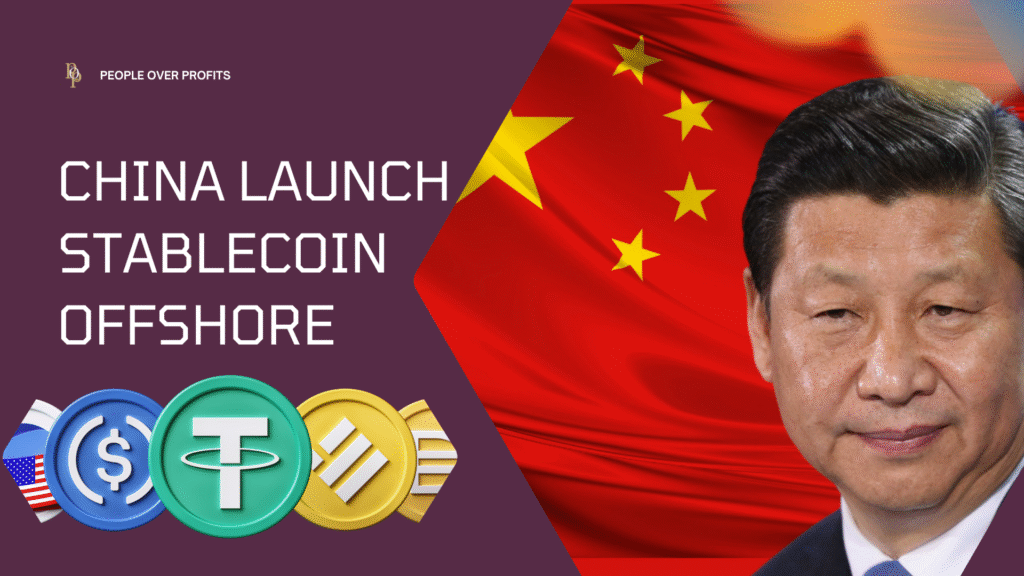Key Takeaways:
- China has launched its first offshore yuan-backed stablecoin (AxCNH) in Kazakhstan, signaling a bold push into blockchain-powered trade.
- The move directly challenges U.S. dollar dominance in global stablecoins while positioning China as a digital finance leader.
- This stablecoin experiment could reshape the future of state-issued digital currencies, with big implications for Web3 adoption.
The crypto world just got a big shake-up as China launched its first offshore yuan-backed stablecoin (AxCNH) in Kazakhstan. This is a bold move, especially from a country that has kept strict bans on domestic crypto trading. Instead of ignoring blockchain, China is strategically testing it abroad to strengthen its role in cross-border trade and global finance.
So, what does this mean for crypto, Web3, and the future of state-backed digital assets? Let’s discuss.
1. China Isn’t Embracing Crypto, It’s Weaponizing Blockchain
While China still bans crypto exchanges at home, this offshore stablecoin shows it’s willing to use blockchain as a geopolitical tool. Instead of Bitcoin or Ethereum, China wants a blockchain future that aligns with its digital yuan (e-CNY) strategy and international trade ambitions.
This is less about decentralization and more about control and influence.
2. The Dollar’s Dominance Is Being Quietly Challenged
Most global stablecoins (like USDT and USDC) are pegged to the U.S. dollar. With a yuan-backed stablecoin, China is signaling: “We want a bigger seat at the global payments table.” If this experiment succeeds, it could reduce dependency on dollar-based stablecoins in regions where China has strong trade ties, such as Central Asia, Africa, and parts of the Middle East.
3. Kazakhstan Is the Perfect Testbed
Kazakhstan has become a strategic partner for China in energy, infrastructure, and digital finance. It’s also crypto-friendly compared to Beijing. Launching AxCNH there allows China to experiment outside its borders while still influencing markets close to home.
Think of it as a “sandbox” for state-controlled Web3 innovation.
4. Private Stablecoins Are in the Crosshairs
China’s stablecoin push isn’t just about global trade, it’s also about outcompeting private stablecoins like Tether and Circle. By offering a state-backed alternative, China can pitch its stablecoin as more secure, trustworthy, and politically aligned with partner nations.
For businesses already working with China, it’s easier to transact in a yuan stablecoin than convert between USDT and e-CNY.
5. The Future of State-Issued Stablecoins Just Got Real
China is not alone. The EU, U.S., and even African financial hubs are exploring stablecoins under their regulatory umbrellas. But China has taken the first big, global swing. This could accelerate a wave of government-backed stablecoins entering the market within the next 2–3 years.
Scenarios to Watch
- Bull Case: China’s offshore stablecoin gains adoption across Belt and Road nations, reducing dollar reliance in trade settlements. This positions China as a leader in blockchain-powered finance while accelerating mainstream stablecoin adoption.
- Bear Case: Global regulators push back, fearing financial fragmentation and currency wars. Businesses avoid adoption due to compliance risks, leaving the stablecoin with limited international impact.
- Base Case: China’s stablecoin sees gradual uptake in select trade corridors like Central Asia but remains niche compared to USDT/USDC. It serves more as a geopolitical experiment than a global market disruptor for now.
What Experts Say
- Crypto Policy Analysts note that this move highlights how blockchain is shifting from retail hype to nation-state strategy.
- Economists also warn that stablecoins tied to government agendas could fragment the global crypto market into competing financial blocs.
- Blockchain Developers see opportunity as state-backed stablecoins may push adoption, but risk watering down the decentralization ethos of web3.
Final Thoughts
China’s offshore stablecoin isn’t just another crypto launch, it’s a strategic power play. It’s about currency influence, digital finance leadership, and controlling the rails of tomorrow’s economy.
For the web3 community, the big question remains: will government-backed stablecoins accelerate mainstream adoption or turn crypto into just another extension of state power?
To stay informed, follow People Over Profits for more breakdowns on how emerging tech, blockchain, and web3 are shaping our shared future.

